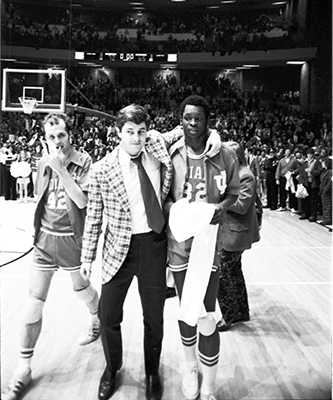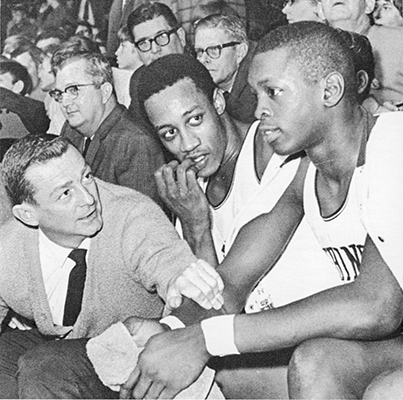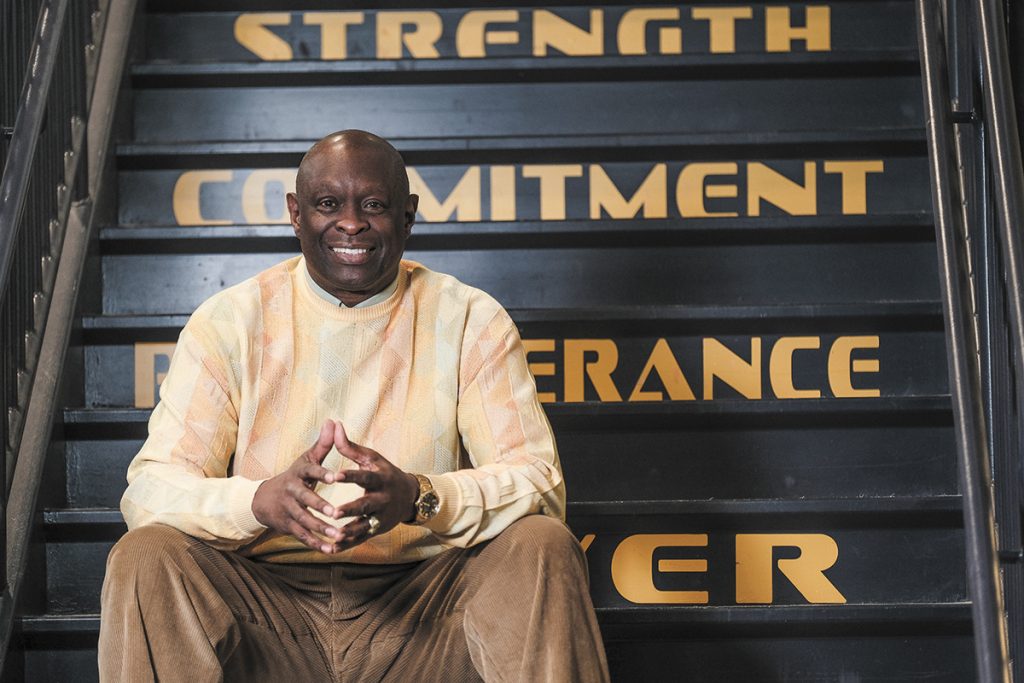Subscriber Benefit
As a subscriber you can listen to articles at work, in the car, or while you work out. Subscribe Now Of all the ways to measure a college athletic program’s success, you might start with parking spots.
Of all the ways to measure a college athletic program’s success, you might start with parking spots.
At Marian University, where Steve Downing has guided a remarkable surge that could have happened in Bloomington instead, it’s nearly impossible these days for visitors to find a space in the physical education complex. The unprecedented success of the school’s teams has led to more sports and new and bigger facilities, which gobbles up acreage, which means fewer parking areas, which means Downing has to walk out of his office and place a blue plastic cone in one of the precious asphalt rectangles so a visitor can leave his car for an hour or two.
“We have a land issue,” university President Daniel J. Elsener says. “We’ve grown.”
And they’re still growing.
Since Elsener hired Downing in 2011 to oversee Marian’s athletics program—“one of the best decisions I’ve made as president”—the university has accumulated a powerful array of teams.
The football team has won two NAIA championships and can boast of the unlikely occurrence of two alums playing in the NFL this past season. The women’s basketball team has won two national titles and the women’s volleyball team one. The women’s soccer team was runner-up for the national championship last year and the football team has been runner-up twice. The men’s basketball team advanced to the Final Four last season, and the women’s softball team reached the NAIA World Series for the fifth consecutive year.
If we’re counting “mere” conference championships, tournament titles and winning seasons, the list would be as long as a CVS receipt.
A lot of good things happen when college teams win, especially for NAIA schools that don’t generate significant money through ticket sales and receive no money from television contracts. Foremost among them, donations to the university increase. Marian’s fundraising has brought in $23 million over the past five years. The goal is to reach $30 million no later than 2025 and Elsener says it will happen long before then.
Enrollment tends to go up, too, partially because people want in on an upbeat, winning environment, whether they like sports or not—especially when more funds are available for financial aid. Marian had a mere 1,000 full- and part-time students in 2002, Elsener’s first full year on the job. It now has 4,500. Construction on a new dormitory will begin later this year, adding more students and subtracting more parking places.
Marian’s athletics portfolio has grown from 21 teams to 27 since Downing arrived. Rugby is the latest addition, and scholarships will be available for it. Old facilities have been remodeled and expanded and the new ones constructed are as appealing as limited land and an NAIA school’s budget permit. They’re filled with modern equipment, and walls are painted bright yellow and blue, the school colors. Messages such as “Be a Knight” and “What Are You Made Of?” adorn the walls in big blue letters.

Blossoming
It’s what Downing is made of that has propelled Marian’s athletic success.
The humble son of a laborer from a family of 10 children, he learned long ago how to relate to people. He’s all at once relaxed, engaging, direct, fun-loving, tough-minded and loyal—therefore a natural at building and maintaining relationships with administrators, coaches, athletes and donors.
“He’s an incredible people person,” says George McGinnis. “He can look at a person and talk to them and get a feeling for what kind of guy or girl he’s dealing with.
“And he really cares about the kids.”
Downing and McGinnis were a tandem on Washington High School’s undefeated state championship basketball team in 1969 and remain tight today. Downing was an all-state center who played without complaint in the shadow of McGinnis, who was a prep All-American and Indiana’s Mr. Basketball on his way to becoming a standout professional and Naismith Hall of Fame inductee. They enrolled at Indiana University and played one varsity season together as sophomores before McGinnis left to sign with the Pacers and help his widowed mother.
That left the 6-foot-8 Downing free to blossom in his own spotlight. As a junior, he scored 47 points and grabbed 25 rebounds while dragging a knee with torn cartilage in a double-overtime upset at seventh-ranked Kentucky, perhaps the greatest individual performance in school history. He won the Chicago Tribune’s Big Ten Most Valuable Player honor as a senior when he averaged 20.1 points and 10.6 rebounds and led IU to the conference championship in 1973. The Hoosiers advanced to the Final Four of the NCAA tournament but lost to eventual champion UCLA in the semifinals, partially because of a controversial block-charge call that went against Downing, the defender, rather than fouling out All-American Bill Walton. Downing outscored Walton 26-14, but IU lost by 11 points. Downing says the play still causes him to wake up in a cold sweat every March.
A first-round draft pick of the Boston Celtics, he played in just 24 games and averaged 2.7 points as a rookie. He did, however, earn a championship ring, one he still wears to show off to Marian recruits.
After playing in three games early in his second season, he was deposited back into the real world. Downing earned a graduate degree in counseling and guidance at IUPUI, then became an associate athletic director at Indiana after three times rejecting Bob Knight’s request to join his coaching staff.
Twenty-two years later, he followed Knight to Texas Tech, where he filled a similar role for 10 years. He really didn’t want to live in the isolation of Lubbock; took four trips there, in fact, before committing. But Knight prevailed upon him.
“He told me how much he needed me, and I said, ‘OK. I’ll do that for you, Coach,’” Downing recalls.
It would have been easy then to portray Downing as a yes-man riding the coattails of a Hall of Fame coach, but that was never the case. Downing was loyal, sure, but never a lackey. He was the rare unintimidated friend who wasn’t afraid to speak up when he thought Knight was wrong. He also wasn’t afraid to make him the butt of jokes.
“What I think he always appreciated was that I was always going to tell him the truth,” Downing says. “I wasn’t going to tell him what he wanted to hear.”
As a result, probably no other former player is closer to Knight today. That was evident when Knight was driven from Bloomington to attend a basketball game at Marian on Jan. 11, a visit Downing didn’t know was coming until three days earlier, when Knight’s wife called to tell him.

‘I do know people’
Downing escaped Lubbock when Bill Smith, a former Marian basketball player who had been a teammate on a college all-star team in 1973, called to tell him of the opening for an athletics director at Marian. They had remained friends, providing one more example of Downing’s knack for maintaining relationships.
He beat out a few other candidates for the job because he and Elsener agreed on a higher ideal than fundraising—an ideal that, because it has been successfully implemented, has contributed greatly to fundraising.
“I said, ‘Hey, look, the best way to grow this university like you want and to raise money to do that is for us to win,’” Downing recalls. “‘And if you hire me, I guarantee you we will win.’”
He didn’t mean at all costs, though. Elsener wouldn’t have accepted that, anyway. A wide receiver on the football team at Nebraska Wesleyan University in his undergrad days, Elsener takes a competitive but idealistic approach to athletics at Marian, viewing it primarily as a laboratory for building leaders. In Downing, he found the perfect kindred spirit.
“It’s one thing to have a vision, but it’s another to have a guy who can pull it off,” Elsener says.
Just as he excelled when McGinnis left him behind at IU, Downing has flourished away from Knight as well. Sidekick or supervisor, he seems to excel in either setting. When he promised Elsener he would build winning programs, he drew confidence in part from his acquaintance with some of the legendary sports figures Knight had brought into Bloomington, such as Bill Parcells, Bill Belichick, Jim Brown, Bo Schembechler and Tony LaRussa.
Downing always made it a point to take them aside and pick their brains.
“I remembered all the things they told me,” he says. “I kept a list.”
“You have to have the athlete’s heart in mind,” he says. “You have to get to where they’ll run through this wall for you. That’s what I preach. Any coach who won’t work with these kids like that, I’m going to get them out of here.
“I don’t know anything about volleyball. I don’t know anything about football. I don’t know soccer, either. But I do know people and how to get them on your side. We’ve been able to win across the board here with that philosophy. I promise you, when you listen to [the men Knight brought in to] talk, you see the commonality.”
Downing was bold from the start, firing eight coaches in his first two years on the job, including a few who had been there more than a decade. But building a stable of winning teams by identifying the right leaders hasn’t been enough. He remains a hands-on overseer.
Options
Follow him through Marian’s immaculate athletic complex and observe his easy conversations with the athletes and other department personnel and it’s obvious (1) he knows them all on a personal level and (2) they respect him. He not only attends the games, he addresses the athletes in team meetings, routinely sits in on the study tables he established, and invites them into his office for individual conversations.
“A coach might say, ‘He’s from the inner city; how do I relate?’” Downing says. “I say, ‘We’re going to hold him accountable just like everybody else.’
“Most of them come from single-parent homes. I tell them, ‘What are you going to do if you don’t graduate? You see who’s committing all the crimes in this city right here. It’s you! That’s what you’re going to do if you leave here with no degree. You’re going to have no good options.’”
Downing knows something about limited options. He badly wanted to become IU’s athletic director years ago but never had the opportunity. He applied twice and was interviewed once but knew all along he had no chance. He also was a finalist for the AD positions at Indiana State, Southern Illinois and Wright State, but says they were seeking fundraisers rather than program builders.
It just so happens IU will be searching for an athletic director to replace Fred Glass this summer. Downing says he won’t apply and has assured Elsener of that. He expects the lack of interest to be mutual, and that’s OK. He’s kept in touch with the power brokers of his alma mater since leaving Bloomington and smiles when he says, “They know I could have done the exact same thing there.”
Besides, he’s 69 years old now, well beyond the age most universities want in a major hire. He’s content where he is, his health is good, and he has no plans to retire anytime soon.
He’ll be at Marian for as long as they can find a parking spot for him.•
__________
Indianapolis native Mark Montieth is a longtime newspaper reporter and freelance writer. He is the author of three books: “Passion Play: Coach Gene Keady and the Purdue Boilermakers,” “Reborn: The Pacers and the Return of Pro Basketball to Indianapolis,” and “Extra Innings: My Life in Baseball” with former Indianapolis Indians president Max Schumacher.
Please enable JavaScript to view this content.


A very nice story about Marian and its success in the sports arena. Too bad it doesn’t mention Dean Peterson and Marian’s cycling team and its national standing and championships.
They had an article in the fall about that! Here it is: https://www.ibj.com/articles/this-coach-has-37-championships-and-helped-restore-the-velodrome
A good read. Thanks.